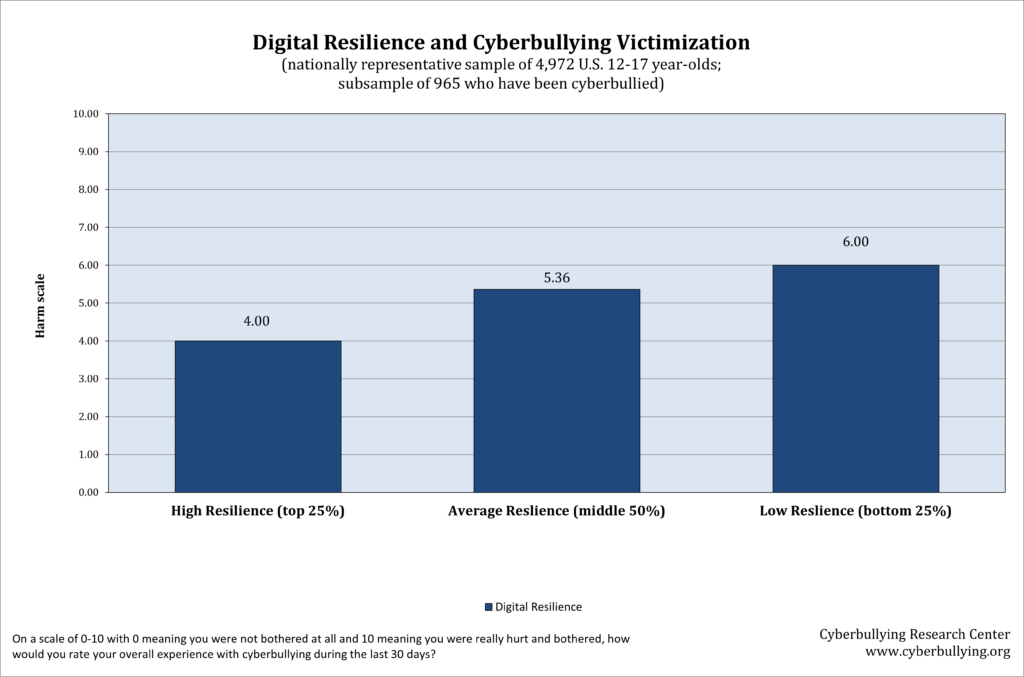
We define digital resilience as “positive attitudes and actions in the face of interpersonal adversity online.” While adversity can arise from technological sources as well (e.g., hard drive crashes, forgotten passwords, vulnerable cloud accounts), we are primarily concerned with the social aspect of online interactions that induce anger, frustration, anxiety, fear, embarrassment, and similar outcomes.
Digital resilience is something that I’ve been thinking about for a few years, especially in the context of finding an answer to what social media companies can do to reduce the effects of toxicity and cyberbullying on their apps. (Before I continue though – a brief caveat: I don’t like slapping the word “digital” on various concepts, as we need to focus on “citizenship” and “civility” and “literacy” and “resilience” in all spheres of life, not just online. But we’re finding something unique here – which I’ll explain below.)
We define digital resilience as “positive attitudes and actions in the face of interpersonal adversity online.”
In 2017, Justin and I published a paper on (traditional) resilience, defined as “the capacity to spring back, rebound, successfully adapt in the face of adversity, and develop social and academic competence despite exposure to severe stress…or simply the stress of today’s world.” Since then, we’ve spoken on the topic multiple times, and audiences have been very receptive to the research-informed, resilience-building strategies we share. It’s become an integral part of our comprehensive message, and we believe it’s making a difference.
However, I have had the nagging suspicion that there was more to be uncovered. The way that we previously measured resilience was based on traditional, validated measures of resilience that focus on offline behaviors (see the study here). They included these items:
- I am able to adapt when changes occur.
- I can deal with whatever comes my way.
- I try to see the humorous side of things when I am faced with problems.
- Having to cope with stress makes me stronger.
- I tend to bounce back after illness, injury, or other hardships.
- I believe I can achieve my goals, even if there are obstacles.
- Under pressure, I stay focused and think clearly.
- I am not easily discouraged by failure.
- I think of myself as a strong person when dealing with life’s challenges/difficulties.
- I am able to handle unpleasant or painful feelings like sadness, fear, and anger.
Using these measures, we found that the lower students scored on their level of resilience, the more likely they were to:
- be significantly negatively impacted at school by bullying
- be significantly negatively impacted by cyberbullying
- get sad, angry, frustrated, fearful, or embarrassed as a result of bullying
- suffer silently and do nothing to improve their situation when bullied
Moving forward, though, I felt like we needed to create some measures of resilience specific to online interpersonal adversity. And if we identified some relevance to cyberbullying with any of these new measures, it may inform what social media companies do to cultivate digital resilience among users (or, at the very least, keep them from unknowingly lowering the resilience of users because of the app design, feature-set, or user experience).
Our Theory
We think there may be something qualitatively different about resilience online when compared to resilience offline. Perhaps a parallel can be drawn to the concept of road rage, which is a type of intermittent explosive disorder that occurs within a unique environment (in a vehicle, while driving). That is, you have an irrational, affective response that hijacks any rational, cognitive response you might want to have. Basically, heavy, negative emotions take over and you internalize and externalize in maladaptive and even harmful ways – harmful to yourself, and harmful towards others. And bam: you have road rage.
This begs the question: Is the Internet, social media, and video gaming a similarly unique environment in which these heavy negative emotions take over, affect you deeply, and contribute to impulsive maladaptive and harmful coping?
If so, how can we encourage healthier and more productive overcoming instead when faced with various forms of online adversity?
Digital Resilience Measures
With this in mind, Justin and I came up with four new measures that assess one’s level of “digital resilience,” and included them in our most recent survey of teens:
- When someone says something hurtful to me online, I can easily laugh it off.
- I am easily frustrated when communicating with people online.
- I find myself responding quickly to emails, text messages, or online posts that make me
upset. - When I have a bad experience online, it sticks with me for a long time.
We then measured these against the amount of harm a target felt or experienced from cyberbullying.

Among the middle and high schoolers who had been cyberbullied, those who scored in the top 25% on digital resilience were significantly less hurt and bothered by the cyberbullying experience. In addition, those with average resilience fared significantly better than those with the lowest levels of resilience when it came to how much a student was negatively affected by cyberbullying.
Among the middle and high schoolers who had been cyberbullied, those who scored in the top 25% on digital resilience were significantly less hurt and bothered by the cyberbullying experience.
Practical Implications to Promote Digital Resilience
So what does this mean? How can this translate into what social media companies do? Here are some ideas:
Resilience-themed messaging and campaigns
1. I would love to see more specific messaging and campaigns to remind users to not let others ruin their online experience, to not give others power if they are being a troll or a jerk, and to remember their own agency and autonomy to control their audience and interactions in-app. I also think that interstitials can be used within various feeds which are bite-sized, punchy, and aesthetically-pleasing and that regularly remind users to refrain from “taking the bait” when others are pressing their emotional buttons. These can offer memorable advice that conveys sentiments like “Keep calm and don’t feed the trolls” and “Is it really worth arguing about that, with them?” and “Don’t let your emotions get the best of you” and “Don’t let anyone live rent-free in your head” and “if they’re toxic, it’s not worth it” and “kill ‘em with kindness.” Focus groups can be held to determine the best wording and approach. In recent months, we have seen some major apps provide in-app messages to users to remind them to be respectful (e.g., YouTube comments), be kind (e.g., Instagram), take breaks (e.g., TikTok), and practice a digital detox (e.g., Bumble). I applaud these initiatives and hope they are making a meaningful difference; although we need to do research to measure its true impact. The point though, is that these reminders can bring a user out of an emotional storm back into a place of rationality, calmness, and control.
Counterspeech tactics
2. It may be time for social media companies to intentionally equip users with points of counterspeech – which are tactics designed to counter hate speech or misinformation (instead of only censoring/blocking them). This way, those users will be proactively equipped to deal with online hate and abuse, rendering them more resilient when it happens. To promote resilience, companies can remind them that:
- users should feel free to denounce hateful speech and actions, because the app/company does as well.
- users can counter any chilling effect that stems from targeted abuse on platforms by speaking up, so that others are emboldened to speak up and seek help when they fear or suffer abuse.
- users have the power to shape the climate through more intentional demonstrations of kindness, tolerance, mutual respect, and civility
- overtly supporting other users of varying demographics and backgrounds through posts, comments, and actions builds solidarity and community
- sharing stories of overcoming harassment by others can encourage and empower others to do the same
- humor and memes can be useful in defusing online conflict, or at least to deflect and distract
Empowerment to raise awareness and change norms
3. Users should know that they can use the app itself to draw attention to cyberbullying, abuse, xenophobia, and other forms of abuse, to educate others about the problematic user and action(s), and to change norms. Some examples (thanks, Daniel Jones and Susan Benesch!) include ByeFelipe on Instagram (which shares screenshots submitted by users of men lashing out after being romantically rejected) and YesYoureRacist which shares racist posts in an attempt to shine a continual spotlight on its reality and harmful implications. Tagging problematic posts and comments with pointed hashtags can also be used to label and more widely publicize instances of hatred and abuse online – and should be employed so that users bent on targeting and victimizing others are not left to operate in the shadows.
In the near future, we will conduct more research to better understand what can foster digital resilience, and what tends to detract from it. We are excited by these initial exploratory findings, and hope to collaborate with social media companies to translate the results to policy and practice. The bottom line is that we must continue to do more to help users who face online adversity keep from internalizing it in ways that compromises their mental health, well-being, and continued participation in these communities, and from externalizing it in ways that hurt others online.
Suggested citation: Hinduja, S. (2020). Digital Resilience. Cyberbullying Research Center. https://cyberbullying.org/digital-resilience
Image source: https://bit.ly/3pFLCxR, SevenFifty1075, Medium.com







